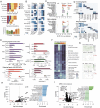This is a preprint.
Single-cell multiome and spatial profiling reveals pancreas cell type-specific gene regulatory programs driving type 1 diabetes progression
- PMID: 40027657
- PMCID: PMC11870426
- DOI: 10.1101/2025.02.13.637721
Single-cell multiome and spatial profiling reveals pancreas cell type-specific gene regulatory programs driving type 1 diabetes progression
Update in
-
Single-cell multiome and spatial profiling reveals pancreas cell type-specific gene regulatory programs of type 1 diabetes progression.Sci Adv. 2025 Sep 12;11(37):eady0080. doi: 10.1126/sciadv.ady0080. Epub 2025 Sep 10. Sci Adv. 2025. PMID: 40929272 Free PMC article.
Abstract
Cell type-specific regulatory programs that drive type 1 diabetes (T1D) in the pancreas are poorly understood. Here we performed single nucleus multiomics and spatial transcriptomics in up to 32 non-diabetic (ND), autoantibody-positive (AAB+), and T1D pancreas donors. Genomic profiles from 853,005 cells mapped to 12 pancreatic cell types, including multiple exocrine sub-types. Beta, acinar, and other cell types, and related cellular niches, had altered abundance and gene activity in T1D progression, including distinct pathways altered in AAB+ compared to T1D. We identified epigenomic drivers of gene activity in T1D and AAB+ which, combined with genetic association, revealed causal pathways of T1D risk including antigen presentation in beta cells. Finally, single cell and spatial profiles together revealed widespread changes in cell-cell signaling in T1D including signals affecting beta cell regulation. Overall, these results revealed drivers of T1D progression in the pancreas, which form the basis for therapeutic targets for disease prevention.
Conflict of interest statement
Declaration of interests The following conflicts of interest are reported for several authors. K.J.G has done consulting for Genentech, received honoraria from Pfizer, holds stock in Neurocrine biosciences, and his spouse is employed by Altos Labs, Inc. J.C. and R.M.E hold stock in and are employed by Pfizer Inc. F.J.T. consults for Immunai, Singularity Bio, CytoReason, Cellarity and Omniscope, and has ownership interest in Dermagnostix and Cellarity.
Figures





References
Publication types
Grants and funding
LinkOut - more resources
Full Text Sources
